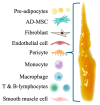The Regenerative Marriage Between High-Density Platelet-Rich Plasma and Adipose Tissue
- PMID: 40076775
- PMCID: PMC11900530
- DOI: 10.3390/ijms26052154
The Regenerative Marriage Between High-Density Platelet-Rich Plasma and Adipose Tissue
Abstract
The use of autologous biological preparations (ABPs) and their combinations fills the void in healthcare treatment options that exists between surgical procedures, like plastic reconstructive, cosmetic, and orthopedic surgeries; non-surgical musculoskeletal biological procedures; and current pharmaceutical treatments. ABPs, including high-density platelet-rich plasma (HD-PRP), bone marrow aspirate concentrates (BMACs), and adipose tissue preparations, with their unique stromal vascular fractions (SVFs), can play important roles in tissue regeneration and repair processes. They can be easily and safely prepared at the point of care. Healthcare professionals can employ ABPs to mimic the classical wound healing cascade, initiate the angiogenesis cascade, and induce tissue regenerative pathways, aiming to restore the integrity and function of damaged tissues. In this review, we will address combining autologous HD-PRP with adipose tissue, in particular the tissue stromal vascular fraction (t-SVF), as we believe that this biocellular combination demonstrates a synergistic effect, where the HD-PRP constituents enhance the regenerative potential of t-SVF and its adipose-derived mesenchymal stem cells (AD-MSCs) and pericytes, leading to improved functional tissue repair, tissue regeneration, and wound healing in variety of clinical applications. We will address some relevant platelet bio-physiological aspects, since these properties contribute to the synergistic effects of combining HD-PRP with t-SVF, promoting overall better outcomes in chronic inflammatory conditions, soft tissue repair, and tissue rejuvenation.
Keywords: adipose-derived mesenchymal stem cells; autologous platelet exosomes; high-density platelet-rich plasma; tissue repair; tissue stromal vascular fraction.
Conflict of interest statement
Peter A. Everts and George Shapiro are CSTO and CMO of the Zeo ScientifiX, Inc. The remaining authors declare that the research was conducted in the absence of any commercial or financial relationships that could be construed as a potential conflict of interest.
Figures







Similar articles
-
Systematic Review: Adipose-Derived Mesenchymal Stem Cells, Platelet-Rich Plasma and Biomaterials as New Regenerative Strategies in Chronic Skin Wounds and Soft Tissue Defects.Int J Mol Sci. 2021 Feb 3;22(4):1538. doi: 10.3390/ijms22041538. Int J Mol Sci. 2021. PMID: 33546464 Free PMC article.
-
Profound Properties of Protein-Rich, Platelet-Rich Plasma Matrices as Novel, Multi-Purpose Biological Platforms in Tissue Repair, Regeneration, and Wound Healing.Int J Mol Sci. 2024 Jul 19;25(14):7914. doi: 10.3390/ijms25147914. Int J Mol Sci. 2024. PMID: 39063156 Free PMC article. Review.
-
Combined platelet-rich plasma and lipofilling treatment provides great improvement in facial skin-induced lesion regeneration for scleroderma patients.Stem Cell Res Ther. 2017 Oct 23;8(1):236. doi: 10.1186/s13287-017-0690-3. Stem Cell Res Ther. 2017. PMID: 29058626 Free PMC article.
-
Concise Review: The Use of Adipose-Derived Stromal Vascular Fraction Cells and Platelet Rich Plasma in Regenerative Plastic Surgery.Stem Cells. 2017 Jan;35(1):117-134. doi: 10.1002/stem.2498. Epub 2016 Oct 24. Stem Cells. 2017. PMID: 27641055 Review.
-
Xenobiotic-Free Medium Guarantees Expansion of Adipose Tissue-Derived Canine Mesenchymal Stem Cells Both in 3D Fibrin-Based Matrices and in 2D Plastic Surface Cultures.Cells. 2020 Dec 2;9(12):2578. doi: 10.3390/cells9122578. Cells. 2020. PMID: 33276432 Free PMC article.
Cited by
-
Platelet-Rich Plasma (PRP) in Reproductive Medicine: A Critical Review of PRP Therapy in Low-Reserve and Premature Ovarian Insufficiency.Biomedicines. 2025 May 21;13(5):1257. doi: 10.3390/biomedicines13051257. Biomedicines. 2025. PMID: 40427083 Free PMC article. Review.
References
-
- Bianchi S., Bernardi S., Mattei A., Cristiano L., Mancini L., Torge D., Varvara G., Macchiarelli G., Marchetti E. Morphological and Biological Evaluations of Human Periodontal Ligament Fibroblasts in Contact with Different Bovine Bone Grafts Treated with Low-Temperature Deproteinisation Protocol. Int. J. Mol. Sci. 2022;23:5273. doi: 10.3390/ijms23095273. - DOI - PMC - PubMed
-
- Brovold M., Almeida J.I., Pla-Palacín I., Sainz-Arnal P., Sánchez-Romero N., Rivas J.J., Almeida H., Dachary P.R., Serrano-Aulló T., Soker S., et al. Naturally-Derived Biomaterials for Tissue Engineering Applications. In: Chun H.J., Park K., Kim C.-H., Khang G., editors. Novel Biomaterials for Regenerative Medicine. Volume 1077. Springer; Singapore: 2018. [(accessed on 23 February 2025)]. pp. 421–449. Advances in Experimental Medicine and Biology. Available online: http://link.springer.com/10.1007/978-981-13-0947-2_23. - DOI - PMC - PubMed
-
- Everts P.A. Autologous Platelet-Rich Plasma and Mesenchymal Stem Cells for the Treatment of Chronic Wounds. In: Hakan Dogan K., editor. Wound Healing—Current Perspectives. IntechOpen; London, UK: 2019. [(accessed on 10 September 2020)]. Available online: https://www.intechopen.com/books/wound-healing-current-perspectives/auto....
Publication types
MeSH terms
LinkOut - more resources
Full Text Sources
Research Materials

